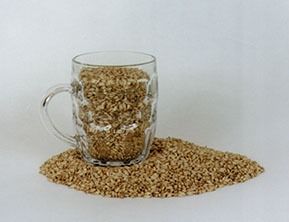Fruit Beer: Tips from the Pros
Brewer: Peter Bouckaert
Brewery: New Belgium Brewing Co., Ft. Collins, Colo.
Years of experience: Nine
Education: Degree in biochemistry in brewery and fermentation technology from CTL in Ghent, Belgium
House Beers: Fat Tire (amber ale), Sunshine Wheat, Old Cherry Ale, Abbey (Belgian double abbey style), Trippel (Belgian triple abbey style); special releases include Frambozen, Saison, Abbey Grand Cru, and Porch Swing (single abbey style)
After harvest New Belgium’s fruit is washed with chlorine-free well water, screened for color, crushed, and frozen. We don’t wash it with city water. The problem you sometimes run into when using city water is the production of chloro-phenols, which are detectable by taste in very low concentrations. Homebrewers who cannot get well water can use a carbon filter.
Pasteurizing your fruit is one of the ways to reduce the microbiological load. In general when pasteurizing, be careful of the oxygen levels. You want to reduce the possibility of oxidation and the flavor it produces. Reducing the size of each piece of fruit makes the process faster and less risky.
We pasteurize the fruit for a few minutes, keeping the temperature below 158° F. But make sure the heat distribution in the whole batch is even. In general you need to pasteurize for a longer time at a lower temperature if the pieces of fruit are large.
There is a risk of contamination when brewing fruit beer. A low-risk beer would be a lambic or sour beers in general because they are already so low in pH and so well fermented. Other beers are more risky when you add fruit to them. Again, try to avoid using whole pieces of fruit and pasteurize.
My experience is mostly with sour beers. They already have a microbiological diversity and are well protected against other microbiological contamination by low pH and lack of remaining nutrients. Fruit contact time for those beers can be months to a year.
Here we keep the fruit in contact for four days for the Old Cherry Ale because that has a low fruit flavor compared with other fruit beers. Our Frambozen, on the other hand, is a very strong fruit beer, both in alcohol and fruit content. We keep the raspberries in for about two weeks.
To avoid tart or bitter flavors we make sure we have a good variety of fruit. You could use sugar to compensate for tartness, but the problem with homebrewing that way is that the sugar will be fermented again. In my experience lactic acid can mellow tart flavors. We do not add anything to sweeten the cherry beer. But we make it so that it has a high remaining extract, which gives it a kind of sweetness. It has been my winter favorite.
To develop the beer’s sweetness you can also use a higher temperature in your mash, around 145° F. You can produce a certain amount of non-fermentable sugars by playing around with mash temperatures (short or no beta-amylase rest or mash in at 162° F) or you can use color malts or cara-pils.
Our raspberry is quite a heavy beer. It’s the basic wort of an abbey, 6.5 percent alcohol by volume. For the United States that’s quite a heavy beer. It’s also quite dark. It has a high starting gravity of 16.5 Plato (1.067 specific gravity).
To prevent the flavor of seeds and pits, they can be screened out, as they are for our Frambozen; covered by remaining sweetness; or reduced by flavor compounds, such as the harshness of hops with wood.
The most common mistakes people make when brewing fruit beer have to do with microbiology and the lack of brightness. Microbiological problems very often include diacetyl off-flavors or acid formation. You can reduce this with proper pasteurization. There are also steps that can be taken to reduce microbiological problems in general. Start with good overall brewing techniques.
To prevent haze in the raspberry beer, we use different kinds of filtration. We first use a centrifuge to remove most of the larger particles. Then we send it twice through our DE (diatomaceous earth) filter. We’ve been searching for other methods but without positive results.
I would recommend homebrewers use less fruit to avoid haze. To compensate for flavor loss, look for a good, strong variety of fruit.
The Tips:
• When pasteurizing fruit, make sure the heat distribution is even.
• Mellow out tart fruit flavors with lactic acid or use of higher temperature in your mash.
• To prevent haze fom fruit, use a filter and reduce the amount of fruit you use.
• To prevent the flavor of seeds and pits, screen them out.







